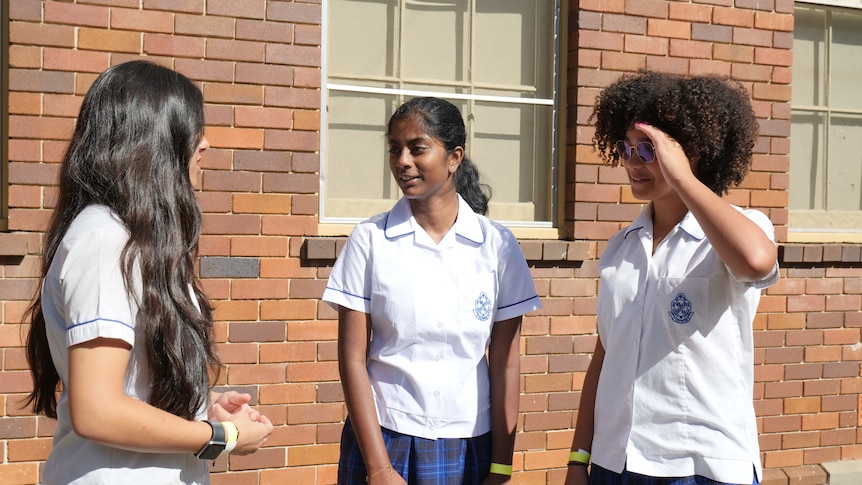Australia Weather News

Macarthur Girls High School is one of a handful of Western Sydney schools where the program is being taught. (ABC Radio Sydney: Declan Bowring)
When it gets hot near Ishika Brahmbatt's Toongabbie home in Western Sydney, you can see the heat rising off the road.
The family usually stays inside, keeps hydrated and tries to sleep it out, but that's not an option when she has to walk 15 minutes to the bus stop before an hour-long commute to school.
"When we're outside on a hot day, it gets extremely hot," Ishika said.
"I have to usually walk to the bus stop, and the trains, and it gets really, really hot at that time."
Tvisha Sejal Jayakar says her neighbourhood in Girraween gets hot because of the amount of dark surfaces, like roofs and the road.
Ishika and Tvisha, who are in Year 10 at Macarthur Girls High School, will be learning about the impacts of urban heat this term in a STEM program taught by Powerhouse Parramatta.
Through the 10-week 50° Climate Heat and Resilience project, students will learn about the urban heat island effect and the impact of heat on their bodies.
Using data loggers and thermal cameras, students will also find out just how hot it gets at their school.
"We know that climate change is here to stay ... heatwaves are predicted to double by 2050," Sophie Poisel, who helped develop the program with Lang Walker Family Academy at Powerhouse Parramatta, said.
"These students and their families are right in one of Western Sydney's hotspots and they need to know how to keep safe."
Part of their education includes a board game that simulates decision-making in local government planning for heatwaves.
Students will also be tasked with finding solutions to heat issues to implement at their schools.
Their findings will be presented at a summit in April attended by academics, industry figures and decision-makers in state government.
Tvisha would like to learn about climate change and explore options that are accessible to people from low socio-economic backgrounds, while Ishika would like to see more shade and water stations.
Year 9 student Dayleni Drike Sanchez would also like to see more bubblers.
"A lot of people don't bring water bottles around and dehydration is really bad," Dayleni said.
The program will also be taught at public high schools in Sydney's west including James Ruse Agricultural, Arthur Phillip, Cumberland, The Ponds, Doonside, Seven Hills, Graville Boys and Holroyd.
Impact of urban heat on people
In Greater Western Sydney, the region's distance from coastline and rapid urban development can see temperatures 10 degrees Celsius higher than the city's east.
Climate modelling has long suggested these temperatures will increase, building to 16 days over 35C by 2030 and 46 days by 2090.
Urban heat expert Professor Sebastian Pfautsch said spreading awareness of both the impact of heat and the built environment's contribution to heat will be an important part of the program.
"There is a clear relationship between extreme heat and mortality and morbidity going up, particularly for the elderly and the very young,"Professor Pfautsch, from Western Sydney University, said.
"There's a lot of weight on the kids' shoulders these days to also keep the family safe and bring that knowledge home from school.
"What we really need to change is how people perceive their environment and make it cooler in the future."
Recently the Bureau of Meteorology confirmed 2024 was the second-hottest year on record, with temperatures 1.55C warmer than the long-term average.
Emma Bacon, who runs the heat awareness advocacy group Sweltering Cities, is interested to hear about the solutions students come up with.
"The students who are doing this are going to be thinking more deeply about the impact of extreme heat on Western Sydney than most politicians in this state or in this country," Ms Bacon said.
"All of the students here are experts in how extreme heat affects them and their families and their communities."
ABC